Task Manager vs Process Explorer
Windows Task Manager, also known as Task Manager is a feature in Windows OS, which is one of the most important and powerful utility. It can manage tasks, applications and services running and can also kill/end them. It is also a monitoring tool, which can be used to monitor your hard disk, memory, CPU and network usage. Killing an unresponsive or misbehaving application is one of the most used feature of the Task Manager. Along with that, starting with Windows 8, Task Manager also has the start-up feature which manages the start-up applications from where you can enable/disable the apps that are set to run when the window starts up.
However, there is an application available which can also be used as an alternative to Task Manger, designed for advanced users which goes by the name of Process Explorer. Process explorer is a part of diagnostic tools from the Sysinternals family which are distributed for free by Microsoft. Process Explorer is the most popularly used tool among them.
Process explorer can give you a lot more information and control over all the applications, processes and services that are running on your computer and also includes all the features the Task Manager has. Process explorer can trace an application down to the last DLL file it is using.
Process Explorer runs without installation, you simply have to run a very small file making it portable. In this guide, we will compare Task Manager with Process Explorer should you wish to use Process Explorer, this guide will help.
Task Manager can be used by a user to know which applications, processes, services are running and also control their priority and the number of processors they can use (affinity) It can also provide you with information about CPU, memory and network usage on your computer – since Task Manager is designed for home and basic use, it won’t help in debugging and doesn’t provide extensive and detailed analysis about the running processes.
Where as Process Explorer gives you all the above information in a very detailed and neat way with a lot of extra features too. Some are mentioned below, but are not nearly all of the features that are buried there in the Process explorer’s interface. If you do want to try the features below too, we recommend you download Process Explorer (Very small in size, 1.2 MB to be exact) and keep it running through the guide.
Click (here) to download the Process Explorer and then open the downloaded file. Double click procexp.exe to run Process Explorer. Accept the EULA by clicking I Agree.
Advanced User Interface
Task manager has pretty much stayed the same in terms of user interface. A user may find especially the Process tabs confusing if he is looking for a single target process to monitor or kill or to see which application is using it. All the processes would look the same to a less tech savvy eye.
Process Explorer is a clear win in this case. It carefully and accurately separates system core processes in pink color and your own manually started processes in blue color. All the processes would have their associated icon next to them and their description too.
Also its tree view organizes the processes in such a way that you can easily know the parent process of a target process on which it running.
The CPU, GPU, network and disk monitoring graphs can be seen on the top too and can be enlarged if clicked on.
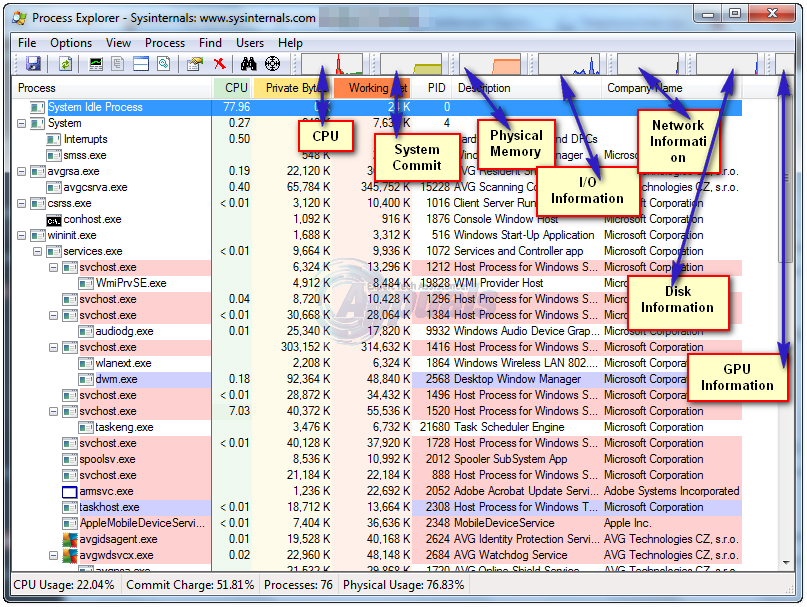
Unlock Files and Folders
Process Explorer is great troubleshooting tool too. If you are unable to delete a file/folder even if you have closed all programs, it can help you trace down to the process and/or DLL handlers that are still unnecessarily locking the file/folder. Then you will be able to delete them.
To do so, simply open Process Explorer and click on the Binoculars icon on top. Type in the file/folder name and click Search.

Select each process in the results and close them by going back to the Process Explorer window, then Right click on the target handler process and click Close Handle/Kill Process.
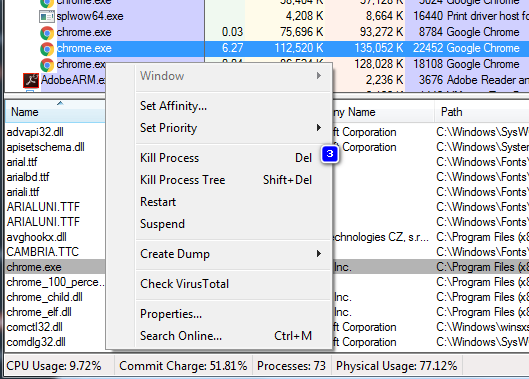
Detailed Information/Analysis
In the Process Explorer window, double click the process to view it’s detailed information. In the property window, you can see its location, current temporary directory, auto start location (if it is configured to run automatically), detailed computer resources usage grouped into network, disk and CPU usage and much more.
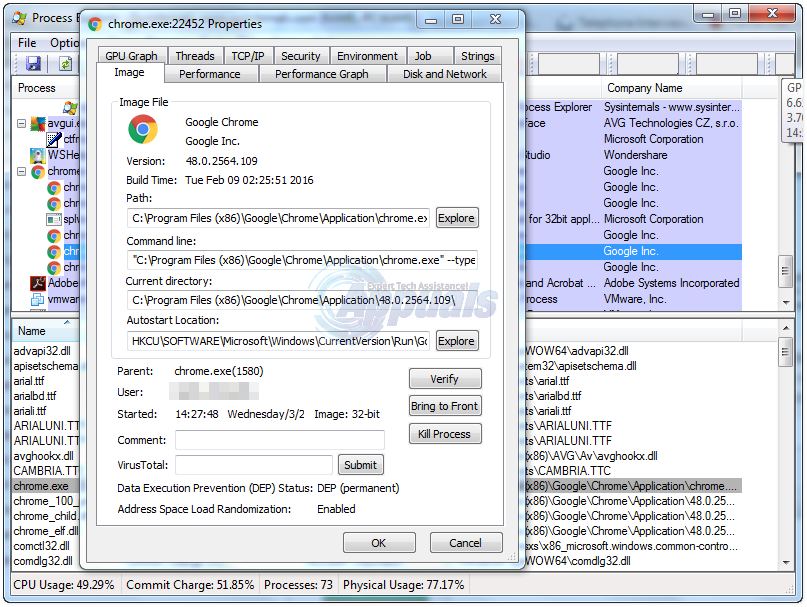
Trace Application’s Process
If you would like to trace a process, and it’s associated file simply drag the cross hair icon to the app and it will show you all related/associated processes.
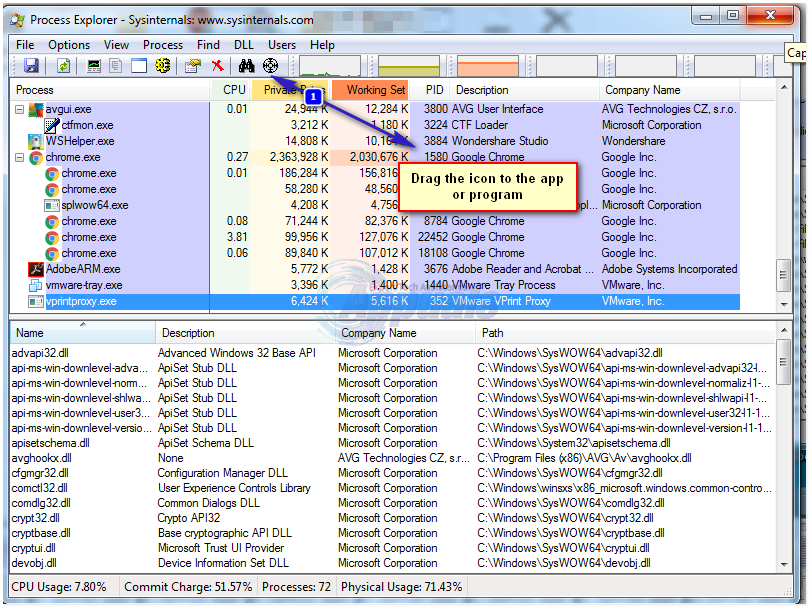
Process Check / Virus Total
Process Explorer can scan for process online, and can also search the process for viruses.

Accessibility / Short Cuts
Task Manager is built into Windows and there are several ways to access it, such as the following Keyboard short-cuts.
Press and Hold Ctrl key + Shift key + Esc
Press and Hold Ctrl key + Alt key + Del Then click Start Task Manager.
Right click on task bar and click Start Task Manager.
Press and Hold Windows key and Press X. Click Task Manager. (Only in Windows 8 and later)
Process Explorer can also be accessed in the same way if replaced. To replace Task Manager with Process Explorer, Open Process Explorer. Click on Options in the menu bar and click Replace Task Manager.
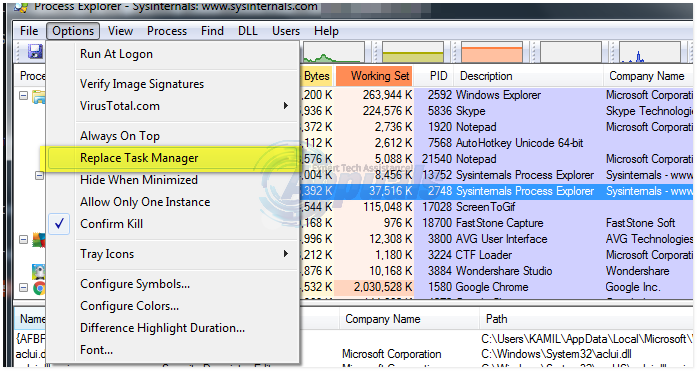
Now you will be able to run Process Explorer the same way as you would run Task manager. So as you can see, this was not much of a competition as Process Explorer is clearly more powerful than task manager.